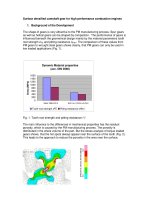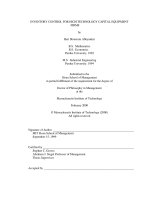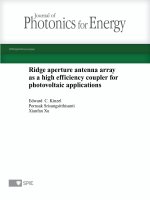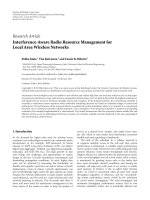Protocols For High Efficiency Wireless Networks
Bạn đang xem bản rút gọn của tài liệu. Xem và tải ngay bản đầy đủ của tài liệu tại đây (10.17 MB, 302 trang )
PROTOCOLS FOR HIGH-EFFICIENCY
WIRELESS NETWORKS
This page intentionally left blank
PROTOCOLS FOR HIGH-EFFICIENCY
WIRELESS NETWORKS
by
Alessandro Andreadis
Giovanni Giambene
KLUWER ACADEMIC PUBLISHERS
NEW YORK, BOSTON, DORDRECHT, LONDON, MOSCOW
eBook ISBN:
Print ISBN:
0-306-47795-5
1-4020-7326-7
©2002 Kluwer Academic Publishers
New York, Boston, Dordrecht, London, Moscow
Print ©2003 Kluwer Academic Publishers
Dordrecht
All rights reserved
No part of this eBook may be reproduced or transmitted in any form or by any means, electronic,
mechanical, recording, or otherwise, without written consent from the Publisher
Created in the United States of America
Visit Kluwer Online at:
and Kluwer's eBookstore at:
Acknowledgments:
The authors wish to thank Prof. Giuliano Benelli for his continuous
help and encouragement.
This page intentionally left blank
Table of contents
PREFACE
XI
PART I: MOBILE COMMUNICATIONS SYSTEMS AND
TECHNOLOGIES
CHAPTER 1: MULTIPLE ACCESS TECHNIQUES FOR WIRELESS
SYSTEMS
1
FREQUENCY DIVISION MULTIPLE ACCESS (FDMA)
TIME DIVISION MULTIPLE ACCESS (TDMA)
RESOURCE REUSE WITH TDMA AND FDMA
CODE DIVISION MULTIPLE ACCESS (CDMA)
DS-CDMA spreading process
Basic considerations on the capacity of DS-CDMA systems
2
2
4
8
11
13
1.1
1.2
1.3
1.4
1.4.1
1.4.2
CHAPTER 2: THE GLOBAL SYSTEM FOR MOBILE COMMUNICATIONS
17
2.1
INTRODUCTION TO GSM
2.1.1
Base station sub-system
Network sub-system
2.1.2
2.2
GSM STANDARD EVOLUTION
GPRS NETWORK ARCHITECTURE
2.3
GSM-GPRS AIR INTERFACE: DETAILS ON PHYSICAL LAYER
2.4
EDGE AND E-GPRS
2.5
RADIO RESOURCE MANAGEMENT CONCEPTS
2.6
QOS ISSUES IN THE GPRS SYSTEM
2.7
GPRS TYPICAL PROCEDURES
2.8
GPRS tunneling protocol architecture
2.8.1
GPRS protocol stack
2.8.2
2.9
GPRS SERVICES
CHAPTER 3: 3G MOBILE SYSTEMS
UMTS TRAFFIC CLASSES
3.1
UMTS ARCHITECTURE DESCRIPTION
3.2
UTRAN RESOURCES
3.3
UMTS AIR INTERFACE: CHARACTERISTICS OF THE PHYSICAL LAYER
3.4
UTRA-FDD physical layer characteristics
3.4.1
Mapping of transport channels onto physical channels
3.4.2
UTRA-TDD physical layer characteristics
3.4.3
VOICE SERVICE IN UMTS
3.5
NEW SERVICE CONCEPTS SUPPORTED BY UMTS
3.6
UMTS RELEASES DIFFERENCES
3.7
17
17
18
20
22
25
29
30
34
38
40
42
43
45
52
55
65
68
69
80
81
82
83
85
viii
Protocols for High-Efficiency Wireless Networks
3.7.1
3.7.2
3.7.3
Release '99
Release 4
Release 5
85
86
87
CHAPTER 4:SATELLITE COMMUNICATIONS
91
4.1
BASIC CONSIDERATIONS ON SATELLITE COMMUNICATIONS
4.1.1
Satellite orbit types
4.1.2
Frequency bands and signal attenuation
Satellite network telecommunication architectures
4.1.3
4.2
DIFFERENT TYPES OF MOBILE SATELLITE SYSTEMS
4.2.1
Satellite UMTS
Future satellite system protocols for high-capacity transmissions
4.2.2
4.3
OVERVIEW OF PROPOSED MOBILE SATELLITE SYSTEMS
93
93
101
102
103
104
106
107
CHAPTER 5:MOBILE COMMUNICATIONS BEYOND 3G
5.1
5.2
115
REVIEW ON NEW ACCESS TECHNOLOGIES
4G VIEW FROM EU RESEARCH PROJECTS
120
123
PART II: SCHEDULING TECHNIQUES, ACCESS SCHEMES
AND MOBILE INTERNET PROTOCOLS FOR WIRELESS
COMMUNICATION SYSTEMS
CHAPTER 1: GENERAL CONCEPTS ON RADIO RESOURCE
MANAGEMENT
127
CHAPTER 2:TRAFFIC MODELS
135
2.1
2.2
2.3
2.4
2.5
2.6
VOICE SOURCES
VIDEO SOURCES
WEB BROWSING SOURCES
SELF-SIMILAR TRAFFIC SOURCES
DATA TRAFFIC SOURCES
CHANNEL MODELS
CHAPTER 3:RRM IN GPRS
3.1
DESCRIPTION OF LAYER 2 PROTOCOLS OF GPRS
MEDIUM ACCESS MODES
3.2
TERMINAL STATES AND TRANSFER MODES
3.3
ACCESS TECHNIQUES
3.4
P-persistent access procedure
3.4.1
One- and two-phase access procedures
3.4.2
Queuing and polling procedures
3.4.3
Paging procedure
3.4.4
A detailed example of a one-phase access procedure
3.4.5
3.5
GPRS PERFORMANCE EVALUATION
CHAPTER 4: RRM IN WCDMA
135
136
139
143
146
147
151
151
152
153
154
155
156
156
157
157
160
165
Protocols for High-Efficiency Wireless Networks
4.1
4.2
4.3
ADOPTED MODELS
DETAILED DESCRIPTION OF THE PROPOSED RRM SCHEME
SIMULATION RESULTS
CHAPTER 5: RRM IN UTRA-TDD
5.1
RADIO INTERFACE PROTOCOL ARCHITECTURE: DETAILS
5.2
TRANSPORT AND PHYSICAL CHANNELS
5.2.1
Spreading for downlink and uplink physical channels
5.2.2
Multiplexing, channel coding and interleaving
MAC LAYER
5.3
5.3.1
MAC services and functions
5.4
RLC SERVICES AND FUNCTIONS
5.5
RESOURCE MANAGEMENT FOR DSCH
Resource allocation and UE identification on DSCH
5.5.1
DSCH model in UTRAN
5.5.2
5.6
PERFORMANCE EVALUATION FOR PACKET TRAFFIC OVER UTRA-TDD
Study assumptions
5.6.1
The proposed RRM scheme
5.6.2
Simulation results
5.6.3
CHAPTER 6:RRM IN WIRELESS MICROCELLULAR SYSTEMS
6.1
6.2
ATB-P PROTOCOL DESCRIPTION
ATB-P PERFORMANCE EVALUATION
CHAPTER 7: RRM IN LEO-MSSS
7.1
7.2
7.3
7.4
7.5
THE CLASSICAL PRMA PROTOCOL IN LEO-MSSS
PRMA WITH HINDERING STATES (PRMA-HS)
MODIFIED PRMA (MPRMA)
DRAMA PROTOCOL
PERFORMANCE COMPARISONS
ix
169
170
172
175
176
177
180
183
183
187
188
190
192
192
193
196
200
201
205
207
211
217
217
219
219
220
223
CHAPTER 8: ANALYTICAL METHODS FOR RRM ANALYSIS AND FINAL
227
CONSIDERATIONS ON RRM TECHNIQUES
8.1
8.2
8.3
8.4
STABILITY STUDY OF PACKET ACCESS SCHEMES
ANALYSIS OF ROUND ROBIN TRAFFIC SCHEDULING
2-MMPP TRAFFIC DELAY ANALYSIS
LESSONS LEARNED ON RRM STRATEGIES
227
234
238
241
CHAPTER 9: A FIRST SOLUTION TOWARDS THE MOBILE INTERNET:
245
THE WAP PROTOCOL
9.1
9.2
9.3
9.3.1
9.4
INTRODUCTION TO WAP
WAP ARCHITECTURE
WAP PROTOCOL STACK
Bearers for WAP on the air interface
TOOLS AND APPLICATIONS FOR WAP
CHAPTER 10: THE MOBILE INTERNET
10.1
IP AND MOBILITY
245
246
249
251
252
257
257
x
Protocols for High-Efficiency Wireless Networks
10.1.1
Mobile IP
Micro-mobility and the Cellular IP approach
10.1.2
10.2 WIRELESS TCP
10.2.1
Mechanisms for improving wireless TCP performance on errorprone channels
10.2.2
End-to-end approach
Split-connection approach
10.2.3
10.2.4
Link layer approach
10.2.5
A final comparison
258
259
263
264
265
266
266
267
REFERENCES
269
BOOK INDEX
283
Preface
Radio transmissions have opened new frontiers allowing the exchange
of information with remote units. From the first applications of
telegraphy and radio broadcast, wireless transmissions have obtained a
great success with the widespread diffusion of mobile communications.
We live in the communication era, where any kind of information must
be easy accessible to any user at any time. Mobile communication
systems are the technical support that allows the realization of such
concepts.
With the term mobile communications we embrace a set of
technologies for radio transmissions, network protocols, mobile
terminals and network elements.
The widespread diffusion of wireless communications is making
national borders irrelevant in the design, delivery and billing of
services, thus requiring international coordination of standardization
efforts in order to evolve regional systems towards global ones.
Parallel to the evolution of radio-mobile systems, we assist to the
massive diffusion of Internet network and contents, thus allowing many
users on the earth to be interconnected and to exchange any kind of
information, data, images and so on.
Hence, there is a quick convergence of mobile communications and
Internet, i.e., mobile computing (see Fig. 1).
xii
Protocols for High-Efficiency Wireless Networks
The first cellular systems became operational at the beginning of 1980
(first-generation, 1G). They employed analog techniques and rapidly
diffused with each country having its own system. A first evolution was
achieved 10 years later by the adoption of digital standards (secondgeneration, 2G). Presently, we are assisting to the deployment of thirdgeneration mobile cellular systems (3G) that under umbrella
recommendations collect at least three different standards. They are
intended to provide the users with high bit-rate transmissions so as to
allow a fast access to the Internet and, in general, multimedia
transmissions on the move [i],[ii].
In some European countries and in Japan the widespread diffusion of
mobile communications has reached the point to surpass the number of
wired phones. This is an important achievement that significantly
highlights the diffusion of mobile communication systems.
Protocols for High-Efficiency Wireless Networks
xiii
The unique capabilities of new cellular systems are expected to provide
users with integrated multimedia applications. Small, powerful,
application-enabled devices will bring mobility needs together with the
desire for data and information. Networks will be based on the IP
protocol [iii], including the support of Quality of Service (QoS) for
differentiated traffic classes.
The air interface still represents the system bottleneck, by limiting the
available user bit-rate due to both spectrum availability and radio
propagation impairments.
At present, some mobile terminals have integrated a Java Virtual
Machine, an important step towards the mobile computing and the
support of typical Internet applications. In fact, the Java language permits
the development of platform-independent applications. Another powerful
tool for the realization of new applications and services is represented by
the eXtensible Markup Language (XML) and related technologies. In
fact, XML can be used to design Web pages that can be adapted to
different Internet access devices and technologies (e.g., mobile terminals
with small displays, Personal Digital Assistants, common personal
computes, etc.) by using the characteristics of the HyperText Transfer
Protocol (HTTP). In fact, an Internet server can be equipped with an
adaptation engine that recognizes the access technology according to
suitable fields in the HTTP packet header; hence, different translation
rules can be used to adapt the XML contents [iv].
However, the expected diffusion of new applications and multimedia
services can be only reached trough a novel system design that takes
into account all the communication aspects from the application layer
to the physical one, according to the OSI standard reference model.
This approach is particularly effective for the air interface. In fact, a
user application cannot be designed without accounting for the limited
bandwidth, error resilience and reduced display sizes on mobile
terminals. In addition to this, the performance of the transport layer
protocol (TCP) must be evaluated in the presence of air interface
resource constraints and the related traffic must be suitably managed to
avoid that transmission delays or channel impairments negatively affect
the TCP throughput. Moreover, the network layer must account for user
mobility and the consequent re-routing of information when a user
changes its cell. The frequency of handoff procedures among adjacent
xiv
Protocols for High-Efficiency Wireless Networks
cells will be exacerbated in future 3G micro-cellular systems. Hence,
the handoff process needs to be particularly optimized to avoid the loss
of information during handoffs. Finally, the medium access control
layer must be able to integrate the support of different traffic classes,
guaranteeing ad hoc QoS levels, fairness among users and high
utilization of radio resources.
All these aspects call for solutions suitably developed for the air
interface [v]. Therefore, the focus of this book is on the optimization of
the protocols at different layers in order to achieve simultaneously the
maximum utilization of radio resources and the maximum satisfaction
of users, two aspects typically in contrast.
This book will cover different wireless communication scenarios and,
in particular: 2.5G and 3G mobile communication systems (i.e., GPRS,
UTRA-FDD and UTRA-TDD); 4G broadband wireless access systems
(e.g., HIPERLAN/2); mobile satellite systems. A complete review of
such systems is carried out in PART I. Then, PART II will first focus
on both the performance evaluation of different resource management
techniques for the above mentioned air interfaces and, then, will
address the protocols at network and transport layers to allow the
mobile access to the Internet (i.e., TCP/IP and WAP). Hence, we will
consider the impact on the throughput of cellular systems due to both
the user mobility and the transmission of data packets on error-prone
channels.
References
[i]
M. Zeng, A. Annamalai, V. K. Bhargava, “Recent Advances in
Cellular Wireless Communications”, IEEE Comm. Mag., pp. 128138, September 1998.
[ii]
Ojanpera and R. Prasad. Wideband CDMA for Third Generation
Mobile Communications. Artech House, October 1998.
[iii] T. Robles, A. Kadelka, H, Velayos, A. Lappetelainen, A. Kassler,
H. Li, D. Mandato, J. Ojala, B. Wegmann, “QoS Support for an
All-IP System Beyond 3G”, IEEE Comm. Mag., pp. 64-72,
August 2001.
Protocols for High-Efficiency Wireless Networks
xv
[iv] Network Working Group, “Hypertext Transfer Protocol HTTP/1.1”, (Web page) URL: />June 1999.
[v]
M. N. Moustafa, I. Habib, M. Naghshineh, M. Guizani, “QoSEnabled Broadband Mobile Access to Wireline Networks”, IEEE
Comm. Mag., Vol. 40, No. 4, pp. 50-56, April 2002.
This page intentionally left blank
Chapter 1: Multiple access techniques for wireless
systems
In a wireless communication system, radio resources must be provided
in each cell to assure the interchange of data between the mobile
terminal and the base station. Uplink is from the mobile users to the
base station and downlink is from the base station to the mobile users.
Each transmitting terminal employs different resources of the cell. A
multiple access scheme is a method used to distinguish among different
simultaneous transmissions in a cell. A radio resource can be a
different time interval, a frequency interval or a code with a suitable
power level. All these characteristics (i.e., time, frequency, code and
power) univocally contribute to identify a radio resource [1]. If the
different transmissions are differentiated only for the frequency band,
we have the Frequency Division Multiple Access (FDMA). Whereas, if
transmissions are distinguished on the basis of time, we consider the
Time Division Multiple Access (TDMA). Finally, if a different code is
adopted to separate simultaneous transmissions, we have the Code
Division Multiple Access (CDMA). However, resources can be also
differentiated by more than one of the above aspects. Hence, hybrid
multiple access schemes are possible (e.g., FDMA/TDMA).
In a cellular system, radio resources can be re-used between sufficiently
far cells, provided that the mutual interference level is at an acceptable
level. This technique is adopted by FDMA and TDMA air interface,
where the reuse is basically of carriers. In the CDMA case, the number of
available codes is so high that the code reuse among cells (if adopted)
does not increase the interference.
In uplink, a suitable Medium Access Control (MAC) protocol is used to
regulate the access of different terminals to the resources of a cell that are
provided by a multiple access scheme [2]. Whereas, in downlink the base
station has to transmit to the different users by means of a suitable
multiplexing scheme. In the case of packet-switched traffics, there is also
a packet scheduling function that has to be implemented in the base
station.
2
Protocols for High-Efficiency Wireless Networks - Part I
The classical multiple access techniques are described below [1].
1.1
Frequency Division Multiple Access (FDMA)
The frequency band available to the system is divided into different
portions, each of them used for a given channel (Fig. 1); the different
channels are distributed among cells (according to a reuse pattern).
Adjacent bands have guard spaces in order to avoid inter-channel
interference. First-generation terrestrial cellular systems (such as
Advanced Mobile Phone System, AMPS, that started operations in USA
on 1979) were based on analog transmissions with frequency modulation
and FDMA [3]. With the evolution towards digital communications, also
TDMA and CDMA access schemes can be implemented.
One disadvantage of FDMA is the lack of flexibility for the support of
variable bit-rate transmissions, an essential prerequisite for future
mobile multimedia communication systems.
1.2
Time Division Multiple Access (TDMA)
In this scheme, each user has assigned the total bandwidth of a carrier for
transmission, but only for a short time interval (slot) that is periodically
repeated according to a time-organization called frame.
Transmission is organized into frames, each of them containing a given
number of slot intervals,
to transmit packets of bits (Fig. 2).
Protocols for High-Efficiency Wireless Networks - Part I
3
For instance, let us refer to the transmission of speech through a digital
communication system. The voice source signal (analogue signal) is
sampled with a suitable rate. Each obtained value is then quantized with a
suitable number of bits. Then, a source coding scheme can be adopted to
reduce the transmission bit-rate. Finally, dynamic compression and
predictive schemes are adopted (accordingly, it is possible to achieve a
low bit-rate voice transmission up to 2.4 kbit/s, for some satellite
systems). Thus, information bits are grouped in packets. A voice source
typically require one packet to be transmitted a in a slot per frame (see the
darkest slots in Fig. 2).
The US digital standard for cellular communications named IS-54 is
based on TDMA and tripled the capacity (= number of simultaneous
users supported per cell) with respect to the AMPS system, at a parity
of total bandwidth [3]. The pan-European standard of secondgeneration cellular systems, GSM (Global System for Mobile
Communications), is based on TDMA. More exactly, GSM adopts a
hybrid scheme of the FDMA/TDMA type: the available bandwidth is
divided among different 200 kHz sub-bands, each of them occupied by
a carrier accessed with a TDMA scheme.
The main disadvantage of TDMA air interfaces is the high peak
transmit power that is required to send packets in the assigned slots.
Moreover, a fine synchronization must be achieved at the beginning of
each transmission for the alignment with the time-frame structure.
Finally, a rigid resource allocation is supported by TDMA: according to
4
Protocols for High-Efficiency Wireless Networks - Part I
the above example of the voice traffic, one slot is assigned to a voice
source also during silent periods among talkspurts.
1.3
Resource reuse with TDMA and FDMA
Cellular systems with TDMA or FDMA techniques are based on the
resource reuse concept. Indeed, due to the limited number of radio
resources, it is necessary to reuse the same resource among sufficiently
distant cells so that the inter-cell interference is negligible. The reuse
distance D, is the distance between two cells that may simultaneously
use the same channel (see Fig. 3). Assuming a hexagonal regular
cellular layout for a given D value, it is possible to divide the total
number of resources into K groups, distributed among the different
cells as in a mosaic. Possible values of K are: 1, 3, 4, 7, 9, . . .
It is possible to prove the following relationship among D, R (the cell
radius) and factor K [4]:
Protocols for High-Efficiency Wireless Networks - Part I
5
The ratio between the power received at the base station from the
desired user of its cell, C, and the power received from co-channel
users in cells at distance D, I, can be expressed as follows:
where is the path loss exponent (varying from 2 to 4, depending on
the cellular environment;
is typical of free space propagation).
For K = 7, we obtain the reuse mosaic shown in Fig. 4 that corresponds
to C/I = 18 dB for
For the sake of completeness it is important to stress the fact that in
practical cases the cellular coverage is not hexagonal regular, but
depends on streets, building heights, obstacles, and so on. A typical
example can be the GSM 900 MHz cellular coverage shown in Fig. 5,
where different colors are related to different cells irradiated by threesectored sites.
6
Protocols for High-Efficiency Wireless Networks - Part I
Let us refer to the classical circuit-switched voice service. On the basis
of the reuse pattern K, if we have S system channels (i.e., frequency
bands with FDMA or slots with TDMA), we may assign Q = S/K
resources per cell (fixed channel allocation). Hence, at most Q
simultaneous circuit-switched phone calls can be managed per cell. A
call generated in a cell where all its Q resources are busy is blocked and
cleared. If we assume that calls arrive in a cell according to a Poisson
process with mean rate and that the channel holding time in a cell, X,
is generally distributed with mean value E[X], the blocking probability
experienced by a call is given by the well-known ERLANG-B
formula, according to an M/G/Q/Q model (M stands for Poisson
arrivals; G means a general call duration time distribution; Q is the
number of requests in service = number of requests that can be hosted
by the system) [5]:
Protocols for High-Efficiency Wireless Networks - Part II
where
7
Erlang.
The maximum cell capacity can be determined as the maximum load in
Erlang,
per cell that can be managed guaranteeing (for
instance)
If each user contributes an elementary load of
Erlang, we may determine the maximum capacity of users per cell,
as:
Fig. 6 shows the behavior of
as a function of Q assuming that
each user contributes a load of 40 mErlang.









